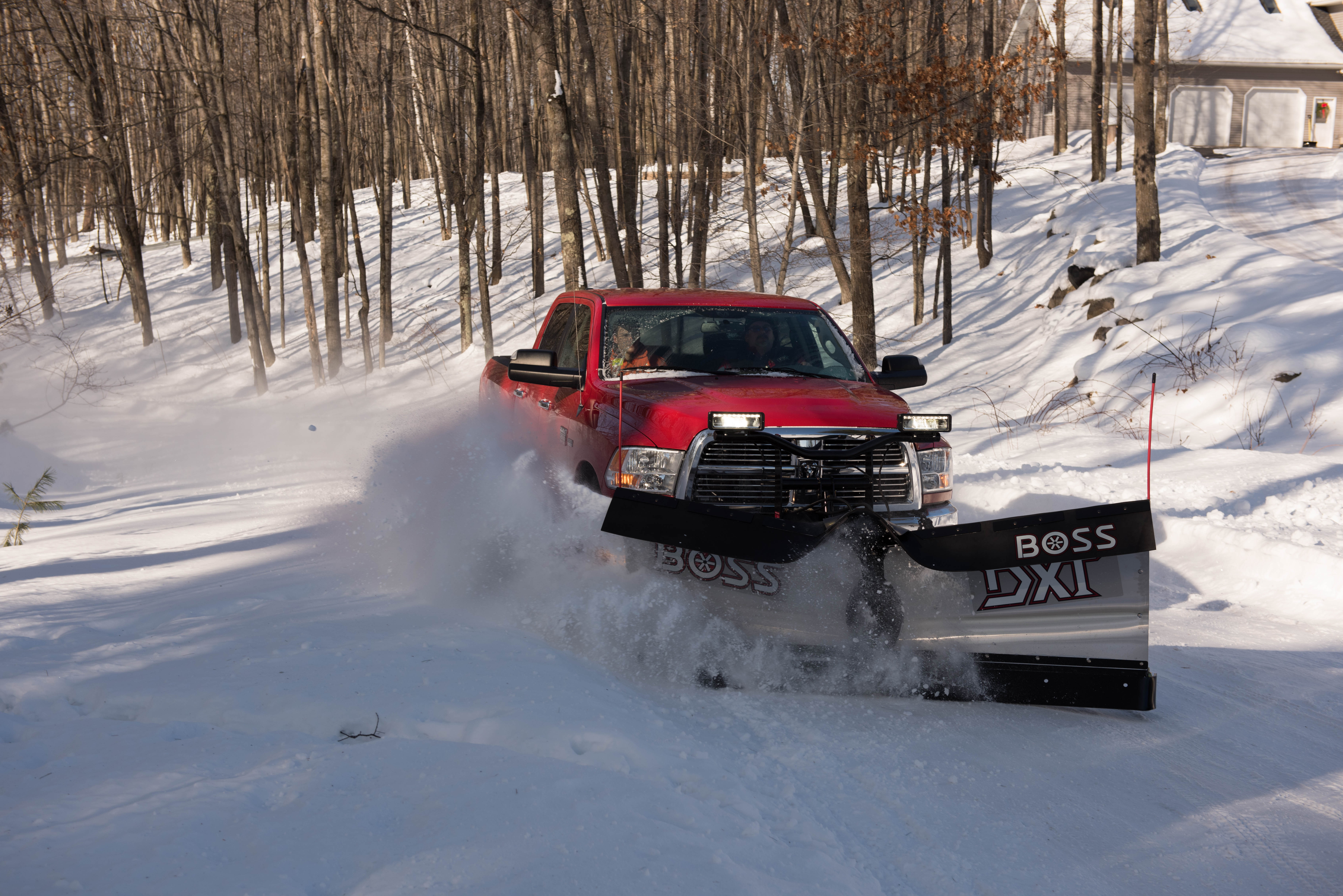A trip system on a plow is a vital component when it comes to safe guarding the plow, truck,
 and operator. Typically, there are two different trip systems used: full-moldboard trip and trip-edge. The two will function differently when encountering obstacles. Generally, most plows are equipped with only one system or none at all, but here at BOSS, we think differently. We sat down with our engineer, Tristan Summers, who designed the DXT, for a personal insight into how the dual-trip plow came about. The DXT snowplow is armed with both a trip-edge and a full-moldboard trip to give you optimal protection against any obstacles you might encounter.
and operator. Typically, there are two different trip systems used: full-moldboard trip and trip-edge. The two will function differently when encountering obstacles. Generally, most plows are equipped with only one system or none at all, but here at BOSS, we think differently. We sat down with our engineer, Tristan Summers, who designed the DXT, for a personal insight into how the dual-trip plow came about. The DXT snowplow is armed with both a trip-edge and a full-moldboard trip to give you optimal protection against any obstacles you might encounter.
Here’s how it works:
-
Trip-edge. The trip-edge will help reduce the impact on your plow should you hit an obstacle smaller than 6 inches high, these are commonly man-hole covers or large cracks in the pavement. When the trip-edge hits these hidden obstructions, the edge of the plow trips backwards to “give way” to the object. This takes some of the force off of the entire plow, which means less damage to the plow itself, the front of your truck, and to you, the operator.
-
Full-Moldboard Trip. As we all know, cracks in the pavement and man-hole covers aren’t the only obstacle out there. A trip-edge does not provide substantial protection when confronted with large icy snow banks or anything taller than 6 inches. That’s where a full-moldboard trip will be beneficial. Should you hit any object taller than 6 inches, the entire moldboard trips forward to cushion the impact. This greatly reduces the force on plow and truck and helps keep you and your equipment safe.
Here’s what Tristan had to say:
What gave you the idea to build a plow like the DXT?
“Basically, I was looking to reduce the amount of force that is transferred into the vehicle. Something that would protect the plow, truck and driver. It just made sense to take two existing systems and put them together.”
Were there any challenges in designing the dual-trip system?
“Yes, the big issues were keeping the weight and complexity down. By keeping those down, the price stays down which makes it more affordable.”
Mechanically, how do the trip systems work?
“Well, the two different trip systems use two different springs. The full-moldboard trip uses 4 extension springs mounted between the Pushframe and Center Section. These springs allow for the plow to trip forward, then contract to bring the blade back to the vertical position. The trip-edge uses 3 torsion springs per blade half. You can think of torsion springs more like a hinge on a door. When the edge trips, the springs tighten. To bring the edge back to the plowing position, the springs will relax.”
What happens when the trip-edge begins to wear?
“It’s inevitable that snowplow cutting edges will wear down. When they have worn down beyond their useable height, you must replace them. This is also true for trip-edge snowplows. When a trip-edge base angle or cutting edge has worn down you must replace it; however, up to the point of replacement the impacts caused by hitting obstacles while plowing become more and more severe. This is a big downfall of a trip-edge only system. You begin with 6 inches of base angle or cutting edge but by the time you need to replace that edge you are worn down to about 3 inches. This means the amount of force required to cause your trip-edge to trip has increased and that means more force being transferred into the vehicle. Think of using a wrench on a bolt, the further toward the end of the wrench, the easier it is to turn. Choke up on the wrench, right next to the bolt you are trying to turn, and it gets much more difficult.”
beyond their useable height, you must replace them. This is also true for trip-edge snowplows. When a trip-edge base angle or cutting edge has worn down you must replace it; however, up to the point of replacement the impacts caused by hitting obstacles while plowing become more and more severe. This is a big downfall of a trip-edge only system. You begin with 6 inches of base angle or cutting edge but by the time you need to replace that edge you are worn down to about 3 inches. This means the amount of force required to cause your trip-edge to trip has increased and that means more force being transferred into the vehicle. Think of using a wrench on a bolt, the further toward the end of the wrench, the easier it is to turn. Choke up on the wrench, right next to the bolt you are trying to turn, and it gets much more difficult.”
In your opinion, why do we make a plow like this?
“We’re always looking out for the safety of the operator and the vehicle. We want to keep them out on the road and protect their equipment, ensuring less downtime and maintenance.”
In short, by having both trip systems on one plow, you maximize the range of protection from potential obstacles. The combination of a full-moldboard trip system and a trip-edge will help keep you and your equipment running for longer.



